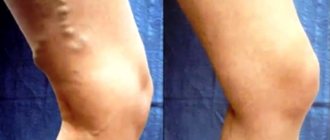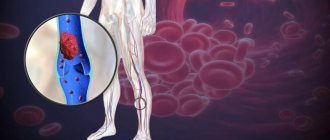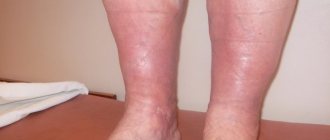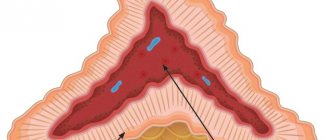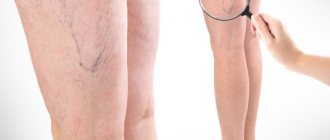Forms of the disease
The classification of thrombosis is quite simple. There are two forms of deep vein thrombosis of the lower extremities, each with distinctive manifestations. The primary form, or phlebothrombosis of the veins of the lower extremities, is especially dangerous. At this stage, the clots are weakly attached to the walls of the vessels. Therefore, the probability of clot rupture is very high, which can lead to severe complications and even death.
The secondary form of the disease is called thrombophlebitis. This pathology entails inflammation of the venous walls. At the same time, the clots are securely fixed on them and come off in extremely rare cases.
Deep vein thrombosis of the lower extremities: causes
Experts identify three main causes of deep vein thrombosis:
- blood clots too quickly;
- the structure of the venous walls has changed (for example, after operations, injuries or injections, due to infectious diseases or allergies);
- stagnation of blood in the veins (with varicose veins or compression of the veins) or slow blood circulation.
Expert opinion
Deep vein thrombosis can occur at different ages. One of the important symptoms that provoke the disease is prolonged standing or sitting, and lack of exercise. Because of this, symptoms of thrombosis of the lower extremities often appear in drivers, pilots, and people with sedentary work.
Vascular surgeon, phlebologist
Osipova Ekaterina Yakovlevna
Pathological factors also include:
- swelling of the legs during pregnancy;
- complicated childbirth (primarily caesarean section);
- severe fractures;
- long flights by plane or travel in a car;
- operations;
- excess weight;
- smoking;
- insufficient fluid intake, which contributes to blood thickening;
- taking blood thickening drugs;
- vascular and heart diseases.
Causes
One of the common causes is the inflammatory process. As a rule, it appears against the background of external trauma.
Another reason for the formation is a slowdown in blood flow due to several factors:
- obesity;
- physical inactivity;
- tumor processes;
- pregnancy;
- forced long horizontal position;
- cardiovascular pathologies.
Impaired hemostasis accompanied by increased coagulability:
- hereditary predisposition;
- pregnancy;
- labor activity;
- dehydration due to infectious diseases;
- surgical interventions;
- the predominance of fatty foods in the diet.
The deep veins of the legs are susceptible to thrombophlebitis because it is in this part of the lower extremities that congestion occurs.
High-risk groups include:
- pregnant women. To prevent illness, it is recommended to wear compression stockings;
- persons whose age has exceeded 40;
- women doing standing work;
- persons suffering from varicose veins;
- persons with addictions: alcohol, smoking, drug addiction.
Deep vein thrombosis of the lower extremities: diagnosis
At the appointment, the specialist visually assesses the patient’s condition and also applies special diagnostic methods. If symptoms of deep vein thrombosis are detected, a special test is performed. The person is asked to raise his foot towards himself: if his lower leg hurts, the diagnosis is indirectly confirmed.
Diagnosis of deep vein thrombosis
Two main methods are used in diagnosing the disease. This is a blood test through blood sampling and duplex examination. Rarely, duplex scanning does not give an accurate result, especially if the thrombus is located too high; X-ray contrast venography is used, injecting special drugs into the vein. This method allows you to reliably determine where the blood clot is located. Sometimes additional diagnostic methods are used if the diagnosis needs to be confirmed.
!
At the first stage, ultrasound diagnostics of the veins is usually performed.
Prevention of thrombosis during pregnancy
It is especially important to avoid thrombosis in women during pregnancy. This is explained by the restructuring of the hormonal background of the female body. The cardiovascular system is under increased stress. Body weight increases and other indicators worsen.
Tablets should be prescribed only if there are serious indications for this. But before this, the expectant mother must change her lifestyle and adhere to a healthy diet. It is recommended to wear compression garments, walk more often and monitor changes in well-being.
Deep vein thrombosis of the lower extremities: symptoms, treatment
At first, deep vein thrombosis is almost invisible. A person can learn about his illness through pulmonary embolism. This complication is registered in half of the sick people.
The most common symptoms of thrombosis of the veins of the lower extremities include the following:
- the leg becomes hot;
- a person feels hot (39 degrees or more);
- it seems that the vein is bursting with pain;
- for no apparent reason, your legs constantly feel heavy;
- the affected leg swells;
- the skin turns blue and shines;
- superficial veins are clearly visible.
As a rule, vein thrombosis shows virtually no symptoms in the first two days. A person may only notice minor pain in the calf. The pain may intensify when moving or touching. Your shins may also become slightly swollen at the bottom.
The ratio of venous and arterial thrombosis
As the disease progresses, symptoms begin to manifest themselves more and more noticeably. The pain intensifies, swelling increases, and the skin turns blue. Symptoms of thrombosis are determined by the location of the clot. If it is located on the thigh, the symptoms will be more severe. The risk of blood clot rupture and complications will also increase.
For example, if the blood clot is in the femoral vein, the swelling will also be localized in the thigh area. If the lesion develops at the level of the iliac vessel, the entire leg from the groin swells. The skin becomes very pale or bluish.
!
The location of the blood clot also influences the development of the disease.
For example, in the last described case, development occurs very quickly: first the limb hurts, then it swells and changes color.
If thrombosis is localized on the lower leg, the disease is accompanied by minor pain. However, the pain may worsen with walking and sports.
Treatment and diagnosis of thrombosis
Treatment of vein thrombosis
As soon as you notice the first signs of thrombosis, do not self-medicate, but immediately go to the doctor! Some patients self-prescribe various treatments, including physical therapy. This can provoke an exacerbation of the disease and even lead to death.
!
When a doctor diagnoses thrombosis, treatment should begin immediately.
If a person's condition is serious, he will be hospitalized. In mild cases, hospitalization is not required. The disease can be treated with medications or surgery.
Medication method
If the diagnosis is detected for the first time, treatment will last up to six months. With repeated manifestations, therapy lasts a year or more. In case of acute thrombosis, the patient goes to the hospital, where he must remain in bed for several days. The bed at the bottom is raised slightly so that blood flows better from the legs. The patient is prescribed heparin therapy, as well as non-steroidal anti-inflammatory drugs.
In some cases, patients are prohibited from moving the affected limb and are prescribed compression garments. When the pain decreases, the person is advised to do special exercises for deep vein thrombosis of the lower extremities in order to improve blood circulation and adjust the diet.
Expert opinion
It is recommended to use venotonic agents to maintain the elasticity and strength of blood vessels and reduce swelling during long-term static loads. The use of such creams is advisable for all people at risk (sedentary lifestyle, excess weight, long journeys), as well as during pregnancy.
Vascular surgeon, phlebologist
Osipova Ekaterina Yakovlevna
Surgical method
If the likelihood of a blood clot breaking off or completely blocking the lumen of the veins is very high, the patient is prescribed surgery. Sometimes doctors temporarily install a special filter to prevent complications of deep vein thrombosis. The walls of the vein can also be sutured - plication. Sometimes blood clots are also removed (thrombectomy).
Another effective treatment method is called thrombolysis. This is the introduction of a special drug into the vessel that dissolves blood clots. The procedure is performed by an experienced surgeon, as it may cause bleeding.
Forecast
If treatment is started in a timely manner, the patient’s chances of a full recovery will be very high. If a person does not begin treatment for the disease, he is likely to develop pulmonary embolism, which can lead to death. Please note that untreated disease leads to complications in 50% of patients within 3 months.
Symptoms and signs of deep thrombophlebitis
Almost always, the disease begins acutely, with severe symptoms developing within a few hours. It is worth noting that the higher the pathology is located in the leg, the more difficult it is, the pain and swelling are much stronger.
The main signs of pathology are pain, redness and thickening of the veins, heaviness in the legs, fatigue, swelling. Often, a phlebologist makes a diagnosis during an in-person consultation, since the symptoms of thrombophlebitis are visually clearly visible. It is also possible to increase body temperature, on average up to 37.5.
In rare cases, a latent course of pathology is possible. For this reason, doctors strongly recommend that patients with venous insufficiency undergo ultrasound examinations several times a year.
Deep vein thrombosis of the lower extremities: treatment with folk remedies
If you have deep vein thrombosis, you should not self-medicate. However, many patients also use folk remedies. In most cases, various tinctures and herbal decoctions are used. The use of such remedies is not prohibited, but it is better to use them in addition to the main treatment program developed by the doctor. This may be a good way to prevent deep vein thrombosis, but it is better to consult a doctor before use. As an alternative to folk remedies, we can recommend special creams of natural origin.
Expert opinion
Folk remedies are made from the roots of medicinal herbs, fruits and flowers of trees. Most often they are applied to the affected limb by rubbing and compresses. Some decoctions can be taken internally.
Vascular surgeon, phlebologist
Osipova Ekaterina Yakovlevna
Tincture on white acacia flowers
To prepare such a remedy, you need one tablespoon of acacia petals. It is poured with 100 ml of alcohol and infused in a closed jar in warmth and darkness. After 10 days, the tincture can be used externally (rub it into the affected leg or make compresses).
Tincture of white cinquefoil root
To make the product, a well-washed and crushed root (50 g) is placed in a glass container and filled with vodka (500 ml). The closed jar is left in a place protected from light for 21 days. After this period has expired, a teaspoon of tincture is drunk three times a day.
Foot baths
One of the popular and useful folk remedies for the prevention of deep vein thrombosis of the lower extremities are foot baths. They help relieve pain and reduce swelling. Tannic root baths are popular. To make a decoction, add 1 kg of root to five liters of water and boil for 60 minutes. You need to steam your feet regularly in the strained broth.
Consumption of propolis
Natural propolis will be useful for vein diseases. It thins the blood and reduces dangerous cholesterol. A teaspoon of propolis (5 g) should be eaten between meals.
!
The product is also recommended as a means of preventing vein diseases.
Onion-honey tincture
It is believed that honey also has a beneficial effect on the condition of blood vessels in the extremities. A widely used folk remedy is onion-honey tincture. To prepare it, you will need a glass of honey and a glass of onion juice. The ingredients are mixed and left warm for 3 days. Then the container is placed in the refrigerator and stored there for another 7 days. A tablespoon of the prepared tincture should be drunk three times a day before meals.
Thrombosis prevention and nutrition
Prevention of venous thrombosis of the lower extremities includes a balanced and healthy diet. It is not difficult to observe: it is enough to limit the consumption of salt, smoked foods, fried and fatty foods, sausages and other unhealthy foods. Junk foods should be replaced with vegetables and fruits, meat and fatty fish.
The diet requires the presence of berries in the diet. It is useful to eat oatmeal, rice broth, flaxseed and olive oils, dishes with ginger and citrus fruits. It is imperative to drink your daily fluid intake - about 1.5-2 liters of clean drinking water.
Flaxseed oil for the prevention of thrombosis
What is it advisable to give up? It is worth limiting the consumption of white bread, dairy products, milk and sugar. Certain types of sausage and fruit can contribute to blood thickening. You need to be careful when taking medicinal herbs: too many herbal infusions can give a negative result.
!
You should not abuse alcohol, you must stop smoking.
The risk group also includes people who uncontrollably take hormonal and diuretic drugs and contraceptives.

